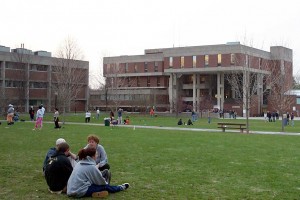Reading Summary 3: Recognizing Campus Landscapes and Learning Spaces

Introduction
There is a significant amount of students enrolled in colleges and universities throughout the United States. The amount of student are intended to rise even more throughout the years. Kathleen G. Scholl and Gowri Betrabet Guulwadi, propose,”… that the natural landscape of a university campus is an attentional learning resource for its students” (53). A university campus is a representation of the learning environment and the university itself. All parts of the university, open and closed spaces, should represent not only the quality of the university but the community it is in as well. Technology may cause students attentional fatigue. Gulwadi and Scholl want to figure out how buildings, open roads and spaces, and natural open learning spaces help to support the learning experiences with the students.
Historical Context of the American College Community
Gulwadi and Scholl begin by describing the definition of the word campus itself. Originally campus was another way of saying field but campuses are now defined as, “…overall physical quality of higher education institutions” (Bowman, 2011). Most universities and colleges were built in rural areas as a way to be secluded the city and city lifestyle. This way students and faculty can have a sense of their own space and environment to learn. After the Morrill Act of 1862. Open space on campuses became more popular and common as a way to introduce different types of studies at universities and colleges. Because of this campuses became more open compared to the previous way campuses were linked together. There was a shift in the way campuses were created and universities and colleges are redefined in this way. After the Second World War, colleges and universities grew and so did their outside spaces. There was a change from usual all pedestrians to lots of students driven and even possibly commuting. With an increase in cars parking lots had to be made available on campuses. Open spaces are used for ecology, agriculture, and other environmental studies. Outside environments must be treated with care and be valued by those who live by campus and the surrounding community in order to preserve the environment.
Concepts of Attention and its Impact on Student Learning
The word landscape describes the relationship between the built environment and nature. Nature is proven to help human cognitive functions such as problem solving and concentration. Involuntary attention of the environment and nature allows students brains to replenish itself involuntary. Having nature around positively benefits the students in ways that may consciously and unconsciously understand.
Holistic Landscapes for Holistic Learning
There are six main settings for human-nature interactions. They consist of indoor, urban, fringe, production landscape, wilderness, and specific species human-nature interactions. These interactions can also take place in three modes which are indirect, incidental, and intentional. Holistic landscapes provide opportunities for students to enjoy nature on an everyday basis. Holistic landscapes also allows holistic learning experiences.
Conclusion
Student learning consists of structured and natural environments. This balance occurs to give college and university students a holistic environment because of the landscape provided. Public trails, study areas, and learning environments give students a chance to explore their campus, community, and a chance to interact with their environment. Colleges and universities go beyond aesthetic value. They advertise the thing that matters the most, the educational value.